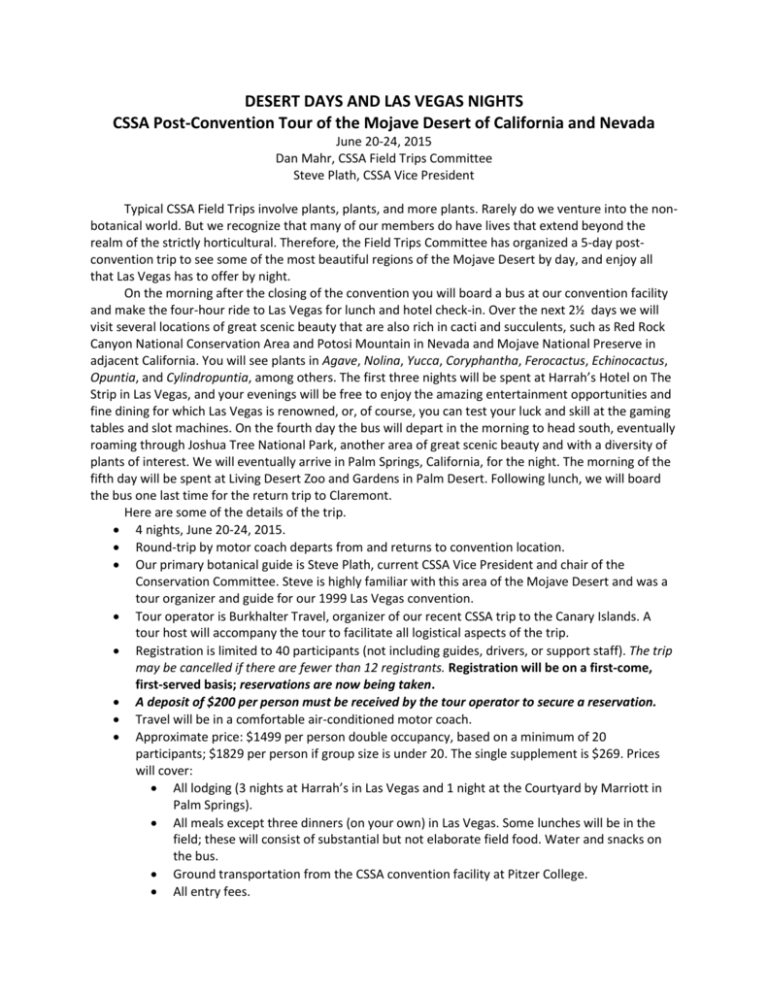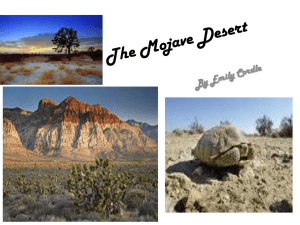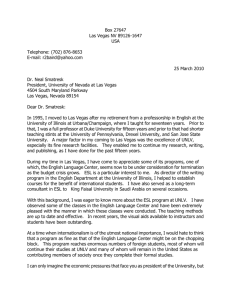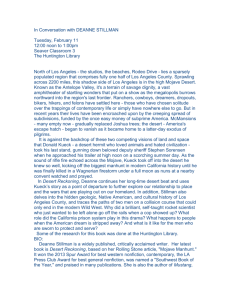CSSA Post-Convention Tour of the Mojave Desert of California and
advertisement

DESERT DAYS AND LAS VEGAS NIGHTS CSSA Post-Convention Tour of the Mojave Desert of California and Nevada June 20-24, 2015 Dan Mahr, CSSA Field Trips Committee Steve Plath, CSSA Vice President Typical CSSA Field Trips involve plants, plants, and more plants. Rarely do we venture into the nonbotanical world. But we recognize that many of our members do have lives that extend beyond the realm of the strictly horticultural. Therefore, the Field Trips Committee has organized a 5-day postconvention trip to see some of the most beautiful regions of the Mojave Desert by day, and enjoy all that Las Vegas has to offer by night. On the morning after the closing of the convention you will board a bus at our convention facility and make the four-hour ride to Las Vegas for lunch and hotel check-in. Over the next 2½ days we will visit several locations of great scenic beauty that are also rich in cacti and succulents, such as Red Rock Canyon National Conservation Area and Potosi Mountain in Nevada and Mojave National Preserve in adjacent California. You will see plants in Agave, Nolina, Yucca, Coryphantha, Ferocactus, Echinocactus, Opuntia, and Cylindropuntia, among others. The first three nights will be spent at Harrah’s Hotel on The Strip in Las Vegas, and your evenings will be free to enjoy the amazing entertainment opportunities and fine dining for which Las Vegas is renowned, or, of course, you can test your luck and skill at the gaming tables and slot machines. On the fourth day the bus will depart in the morning to head south, eventually roaming through Joshua Tree National Park, another area of great scenic beauty and with a diversity of plants of interest. We will eventually arrive in Palm Springs, California, for the night. The morning of the fifth day will be spent at Living Desert Zoo and Gardens in Palm Desert. Following lunch, we will board the bus one last time for the return trip to Claremont. Here are some of the details of the trip. 4 nights, June 20-24, 2015. Round-trip by motor coach departs from and returns to convention location. Our primary botanical guide is Steve Plath, current CSSA Vice President and chair of the Conservation Committee. Steve is highly familiar with this area of the Mojave Desert and was a tour organizer and guide for our 1999 Las Vegas convention. Tour operator is Burkhalter Travel, organizer of our recent CSSA trip to the Canary Islands. A tour host will accompany the tour to facilitate all logistical aspects of the trip. Registration is limited to 40 participants (not including guides, drivers, or support staff). The trip may be cancelled if there are fewer than 12 registrants. Registration will be on a first-come, first-served basis; reservations are now being taken. A deposit of $200 per person must be received by the tour operator to secure a reservation. Travel will be in a comfortable air-conditioned motor coach. Approximate price: $1499 per person double occupancy, based on a minimum of 20 participants; $1829 per person if group size is under 20. The single supplement is $269. Prices will cover: All lodging (3 nights at Harrah’s in Las Vegas and 1 night at the Courtyard by Marriott in Palm Springs). All meals except three dinners (on your own) in Las Vegas. Some lunches will be in the field; these will consist of substantial but not elaborate field food. Water and snacks on the bus. Ground transportation from the CSSA convention facility at Pitzer College. All entry fees. A $100 donation to CSSA. Prices will not include: Alcoholic beverages. Gratuities for tour and hotel staff. Personal items. Trip insurance (recommended). This trip is organized to provide an opportunity for convention attendees to participate in a meaningful field experience. Therefore, convention attendees will have registration priority for this trip. However, if you are not attending the convention but are interested in participating in this trip, please ask to have your name placed on the “space-available list”; any such seats will be filled on a first-come, first-served basis. All participants must be CSSA members or associate members, with dues paid for 2015. Note that weather during this time of the year will be very hot and dry. Although many of the plants of interest will be seen within a short distance of the bus, at some locations short to moderate hikes are planned that will be easy to moderately strenuous. Walking in hot, rocky desert terrain is accompanied by some risk and participants must be aware of their own limitations. Anyone not wishing to participate in a given hike is welcome to stay near or on the bus. ITINERARY. The following itinerary is planned. It is subject to change both before departure and during the trip, depending on unforeseen circumstances. Note that there will be multiple plant stops each field day, depending on travel distances, floristic richness, weather, and other circumstances. Plants listed below are likely possibilities and though they cannot be guaranteed, they do serve as examples of the genera likely to be seen during the trip. Day 1: Saturday, June 20. We will have an early departure from the convention facility at Pitzer College for the approximate four hour motor coach ride to Las Vegas, where we will unload our luggage, check in to the hotel, and have a welcome lunch and orientation from our guides and host. At 2:00 we will again board the bus for the 30 minute ride to Red Rock Canyon National Conservation Area where 23 short hikes will allow us to see such plants as Escobaria vivipara, Ferocactus cylindraceous ssp. lecontei, and Agave utahensis (“nevadensis” form). Return to Las Vegas for dinner and evening activities on your own. Day 2: Sunday, June 21. Drive to Potosi Mountain and Mountain Springs area to see Echinocereus mojavensis, Escobaria vivipara, Opuntia chlorotica, and Agave utahensis. Then on to Blue Diamond to see Cylindropuntia multigeniculata, Echinocereus engelmannii, Mammillaria tetrancistra, and three species of Yucca. A box lunch will be provided for the transitional ride to Searchlight, Nevada for Sclerocactus johnsonii, Echinocactus polycephalus, three species of Cylindropuntia, and Opuntia basalaris. Return to the hotel for dinner and evening activities on your own. Day 3: Monday, June 22. Today we drive to the Mojave National Preserve. Created in 1994, it is one of the newest components of the National Parks program, and at 1.6 million acres, it is the third largest unit of the National Park System in the 48 contiguous United States. It contains the densest stand of the northern form of the Joshua tree, Yucca brevifolia. Sometimes considered as a variety, jaegeriana, it differs notably from the typical form in that it branches while still short in stature. At Cima Dome we will take a 4-mile round trip hike through an outstanding grove of these trees to Teutonia Peak. The first part of the trail is a very easy and gradual uphill walk, but the trail gets moderately steeper closer to the peak. Along the way you will also see Yucca baccata, three opuntias, at least two chollas (Cylindropuntia), Grusonia parishii, Ferocactus cylindraceous, Echinocactus polycephalus, Escobaria vivipara, Mammillaria tetrancystra, and two species of Echinocereus. Eat your box lunch on the bus en route north to the Kingston Mountain Range to see large specimens of the form of Nolina parryi sometimes called N. wolfii. Once again you will have the evening free for dining, leisure, and entertainment on your own in Las Vegas. Day 4: Tuesday, June 23. This morning we leave Las Vegas, heading south for a day of touring and short hikes in Joshua Tree National Park. Here you will see the southern “typical” form of Joshua tree, often in very impressive stands, as well as magnificent desert scenery. The park is also home to 14 species of cacti, some of which will now be familiar from previous stops on the tour. Other succulents in the park include two varieties of Agave deserti, two species of Nolina, Dudleya saxosa, and Fouquieria splendens. Other showy plants of interest include the desert smoke tree, California juniper, and the California fan palm. In late afternoon we will leave the park and ride to Palm Springs to check in to our hotel for one night, The Courtyard by Marriott. This evening we will have our farewell group dinner. Day 5: Wednesday, June 24. This morning we will visit The Living Desert Zoo and Gardens in Palm Desert California. Here we have transitioned from the Mojave Desert to the Colorado Desert, which is a subsection of the larger Sonoran Desert. The Living Desert was established in 1970 to protect a portion of the Colorado Desert, which has its own unique flora and fauna. Today the Living Desert comprises 1200 acres of which 1000 are maintained in their natural condition. The remainder consists of various educational exhibits featuring both plants and animals from desert environments around the world. There are about 30 distinct geographical and taxonomic gardens, primarily featuring plants from arid regions of North America and Africa (including a nice Madagascar garden). The Living Desert also does research on evaluating plants for horticultural purposes in hot dry climates. There is a nice gift shop and even a nursery where desert-adapted plants (including succulents!) can be purchased. By late morning we will have lunch, then board the bus for the return trip to Claremont, with an anticipated mid- to late afternoon arrival. RESERVATIONS. Reservations are now being taken, on a first-come, first-served basis. Registration for this tour will be handled directly by Burkhalter Travel. A deposit of $200 per participant will be required at registration; the balance will be due April 1. For additional information, including a registration form, contact Wendy Bartnick at Burkhalter Travel: wbartnick@burkhaltertravel.com Phone: 1-800-556-9286 ext. 251; Fax: 608-833-8527 Burkhalter Travel 6501 Mineral Point Road Madison, WI 53705 USA MORE INFORMATION? For further information on the botanical aspects of this trip, or for more information on matters relating to CSSA and its Field Trips Program, contact Field Trips Committee Chair Dan Mahr at dmahr@entomology.wisc.edu or phone 608-837-9340. CSSA Field Trips are not collecting trips. All U.S. laws and regulations must be observed.






